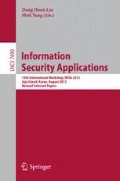Abstract
There are ways to detect malicious web pages, two of which are dynamic detection and static detection. Dynamic detection has a high detection rate but uses a high amount of resources and takes a long time, whereas static analysis only uses a small amount of resources but its detection rate is low. To minimize the weaknesses of these two methods, a filtering method was suggested. This method uses static analysis first to filter normal web pages and then uses dynamic analysis to test only the remaining suspicious web pages. In this filtering method, if a page is classified as normal at the filtering stage, it is not being tested any more. However, the existing filtering method does not consider this problem. In this paper, to solve this problem, our proposed filtering method utilizes a cost-sensitive method. Also, to increase the efficiency of the filter, features are grouped as three subsets depending on the difficulty of the extraction. The efficiency of the proposed filter can be increased, as our method only uses the necessary feature subset according to the characteristics of the web pages. An experiment showed that the proposed method shows fewer false negatives and greater efficiency than an existing filtering method.
Access this chapter
Tax calculation will be finalised at checkout
Purchases are for personal use only
Preview
Unable to display preview. Download preview PDF.
References
Bannur, S.N., Saul, L.K., Savage, S.: Judging a site by its content: learning the textual, structural, and visual features of malicious web pages. In: Proceedings of the 4th ACM Workshop on Security and Artificial Intelligence, pp. 1–10. ACM (2011)
Canali, D., Cova, M., Vigna, G., Kruegel, C.: Prophiler: A fast filter for the large-scale detection of malicious web pages. In: Proceedings of the 20th International Conference on World Wide Web, pp. 197–206. ACM (2011)
Cova, M., Kruegel, C., Vigna, G.: Detection and analysis of drive-by-download attacks and malicious javascript code. In: Proceedings of the 19th International Conference on World Wide Web, pp. 281–290. ACM (2010)
Domingos, P.: Metacost: A general method for making classifiers cost-sensitive. In: Proceedings of the Fifth ACM SIGKDD International Conference on Knowledge Discovery and Data Mining, pp. 155–164. ACM (1999)
Eshete, B., Villafiorita, A., Weldemariam, K.: Malicious website detection: Effectiveness and efficiency issues. In: First SysSec Workshop (SysSec 2011), pp. 123–126. IEEE (2011)
Hou, Y.T., Chang, Y., Chen, T., Laih, C.S., Chen, C.M.: Malicious web content detection by machine learning. Expert Systems with Applications 37(1), 55–60 (2010)
JSUnpack, http://jsunpack.jeek.org
Likarish, P., Jung, E., Jo, I.: Obfuscated malicious javascript detection using classification techniques. In: 4th International Conference on Malicious and Unwanted Software (MALWARE 2009), pp. 47–54. IEEE (2009)
Nazario, J.: Phoneyc: a virtual client honeypot. In: Proceedings of the 2nd USENIX Conference on Large-Scale Exploits and Emergent Threats: Botnets, Spyware, Worms, and More, p. 6. USENIX Association (2009)
The Honeynet Project. Capture-hpc, https://projects.honeynet.org/capture-hpc/
Quinlan, J.R.: Induction of decision trees. Machine Learning 1(1), 81–106 (1986)
Quinlan, J.R.: C4. 5: programs for machine learning. Morgan Kaufmann (1993)
Seifert, C., Welch, I., Komisarczuk, P.: Identification of malicious web pages with static heuristics. In: Australasian Telecommunication Networks and Applications Conference, ATNAC 2008, pp. 91–96. IEEE (2008)
Tao, W., Shunzheng, Y., Bailin, X.: A novel framework for learning to detect malicious web pages. In: 2010 International Forum onInformation Technology and Applications (IFITA), vol. 2, pp. 353–357. IEEE (2010)
Wang, K.: Mitre honeyclient development project. Internet, http://honeyclient.org (accessed: March 2009)
Wang, Y.M., Beck, D., Jiang, X., Roussev, R., Verbowski, C., Chen, S., King, S.: Automated web patrol with strider honeymonkeys. In: Proceedings of the 2006 Network and Distributed System Security Symposium, pp. 35–49 (2006)
Author information
Authors and Affiliations
Editor information
Editors and Affiliations
Rights and permissions
Copyright information
© 2012 Springer-Verlag Berlin Heidelberg
About this paper
Cite this paper
Choi, J., Kim, G., Kim, T.G., Kim, S. (2012). An Efficient Filtering Method for Detecting Malicous Web Pages. In: Lee, D.H., Yung, M. (eds) Information Security Applications. WISA 2012. Lecture Notes in Computer Science, vol 7690. Springer, Berlin, Heidelberg. https://doi.org/10.1007/978-3-642-35416-8_17
Download citation
DOI: https://doi.org/10.1007/978-3-642-35416-8_17
Publisher Name: Springer, Berlin, Heidelberg
Print ISBN: 978-3-642-35415-1
Online ISBN: 978-3-642-35416-8
eBook Packages: Computer ScienceComputer Science (R0)

